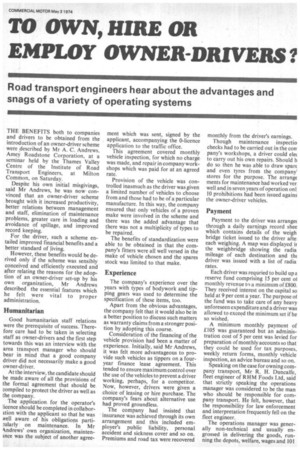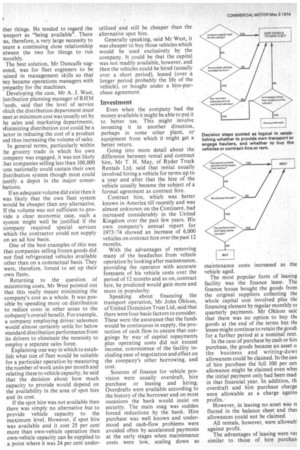TO OWN, HIRE OR EMPLOY OWNE1fDRIVERS ?
Page 29

Page 30

If you've noticed an error in this article please click here to report it so we can fix it.
Road transport engineers hear about the advantages and snags of a variety of operating systems
THE BENEFITS both to companies and drivers to be obtained from the introduction of an owner-driver scheme were described by Mr A. C. Andrews, Amey Roadstone Corporation, at a seminar held by the Thames Valley Centre of the Institute of Road Transport Engineers, at Milton Common, on Saturday.
Despite his own initial misgivings, said Mr Andrews, he was now convinced that an owner-driver scheme brought with it increased productivity, better relations between management and staff, elimination of maintenance problems, greater care in loading and avoidance of spillage, and improved record keeping.
For the driver, such a scheme entailed improved financial benefits and a better standard of living.
However, these benefits would be derived only if the scheme was sensibly conceived and efficiently executed and after relating the reasons for the adoption of an owner-driver set-up by his own organization, Mr Andrews described the essential features which he felt were vital to proper administration.
Humanitarian
Good humanitarian staff relations were the prerequisite of success. Therefore care had to be taken in selecting staff as owner-drivers and the first step towards this was an interview with the area transport manager who should bear in mind that a good company driver did not necessarily make a good owner-driver.
At the interview, the candidate should be made aware of all the provisions of the formal agreement that should be compiled to protect the driver as well as the company.
The application for the operator's Licence should be completed in collaborWon with the applicant so that he was veil aware of his obligations partimlarly on maintenance. In Mr 6(ndrews' own organization, maintenince was the subject of another agree ment which was sent, signed by the applicant, accompanying the 0-licence application to the traffic office.
This agreement covered monthly vehicle inspection, for which no charge was made, and repair in company workshops which was paid for at an agreed rate.
Provision of the vehicle was controlled inasmuch as the driver was given a limited number of vehicles to choose from and those had to be of a particular manufacture. In this way, the company ensured that only vehicles of a proven make were involved in the scheme and there was the added advantage that there was not a multiplicity of types to be repaired.
The benefits of standardization were able to be obtained in that the company's fitters were all well versed in the make of vehicle chosen and the spares stock was limited to that make.
Experience
The company's experience over the years with types of bodywork and tipping gears was used to determine the specification of these items, too.
Apart from the obvious advantages, the company felt that it would also be in a better position to discuss such matters as warranty claims from a stronger position by adopting this course.
Consideration of the financing of the vehicle provision had been a matter of experience. Initially, said Mr Andrews, it was felt more advantageous to provide such vehicles as tippers on a fouryear finance lease agreement. This tended to ensure maximum control over the use of the vehicles to prevent a driver working, perhaps, for a competitor. Now, however, drivers were given a choice of leasing or hire purchase. The company's fears about alternative use had proved groundless.
The company had insisted that insurance was achieved through its own arrangement and this included employer's public liability, personal accident and sickness cover and so on. Premiums and road tax were recovered monthly from the driver's earnings.
Though maintenance inspectio checks had to be carried out in the con pany's workshops, a driver could ele( to carry out his own repairs. Should h do so then he was able to draw spare and even tyres from the company' stores for the purpose. The arrange ments for maintenance had worked ver well and in seven years of operation onl 10 prohibitions had been issued agains the owner-driver vehicles.
Payment
Payment to the driver was arrange( through a daily earnings record shee which contains details of the weigh bridge ticket issued to the driver afte, each weighing. A map was displayed ir the weighbridge showing the radia mileage of each destination and th( driver was issued with a list of radia rates.
Each driver was requried to build up a reserve fund comprising 15 per cent ol monthly revenue to a minimum of £800. They received interest on the capital so held at 9 per cent a year. The purpose of the fund was to take care of any heavy unforeseen expenditure and a driver was allowed to exceed the minimum set if he so wished.
A minimum monthly payment of £105 was guaranteed but an administration cost of 5 per cent was levied for preparation of monthly accounts so that they could be used for tax purposes, weekly return forms, monthly vehicle inspection, an advice bureau and so on.
Speaking on the case for owning company transport, Mr R. H. Duncalfe, fleet engineer of RH M Foods Ltd, said that strictly speaking the operations manager was considered to be the man who should be responsible for company transport. He felt, however, that the responsibility for law enforcement and interpretation frequently fell on the fleet engineer.
The operations manager was generally non-technical and usually engrossed in delivering the goods, running the depots, welfare, wages and 101 ther things. He tended to regard the .ansport as "being available". There
as, therefore, a very large necessity to nsure a continuing close relationship etween the two for things to run rnoothly.
The best solution, Mr Duncalfe sugested, was for fleet engineers to be rained in management skills so that hey became operations managers with ympathy for the machines.
Developing the case, Mr A. J. West, listribution planning manager of RHM 'oods, said that the level of service vhich the distribution department must fleet at minimum cost was usually set by he sales and marketing departments. vlinimizing distribution cost could be a actor in reducing the cost of a product Ind thus increasing the volume of sales.
In general terms, particularly within :he grocery trade in which his own :.ompany was engaged, it was not likely :hat companies selling less than 100,000 tons nationally could sustain their own distribution system though most could justify a depot in the major conurbations.
If an adequate volume did exist then it was likely that the own fleet system would be cheaper than any alternative. If the volume was not sufficient to provide a clear economic case, such a system might well be justified if the company required special services which the contractor could not supply on an ad hoc basis.
One of the best examples of this was that companies selling frozen goods did not find refrigerated vehicles available other than on a contractual basis. They were, therefore, forced to set up their own fleets.
Returning to the question of minimizing costs, Mr West pointed out that this really meant minimizing the company's cost as a whole. It was possible by spending more on distribution to reduce costs in other areas to the company's overall benefit. For example, a company employing driver/ salesmen would almost certainly settle for below standard distribution performance from its drivers to eliminate the necessity to employ a separate sales force.
Explaining one way in which to establish what size of fleet would be suitable for a particular operation by measuring the number of work units per month and relating these to vehicle capacity, he said that the decision about how much capacity to provide would depend on the availability in the area of spot hire and its cost.
If the spot hire was not available then there was simply no alternative but to provide vehicle capacity to the maximum level. However, if spot hire was available and it cost 25 per cent more than own-vehicle operation then own-vehicle capacity can be supplied to a point where it was 24 per cent under
utilized and still be cheaper than the alternative spot hire.
Generally speaking, said Mr West, it was cheaper to buy those vehicles which would be used exclusively by the company. It could be that the capital was not readily available, however, and then the vehicles could be hired (usually over a short period), leased (over a longer period probably the life of the vehicle), or bought under a hire-purchase agreement.
Investment
Even when the company had the money available it might be able to put it to better use. This might involve investing it in another direction, perhaps in some other plant, or equipment from which it might get a better return.
Going into more detail about the difference between rental and contract hire, Mr T. H. May, of Ryder Truck Rentals Ltd, said that rental usually involved hiring a vehicle for terms up to a year and after that the hire of the vehicle usually became the subject of a formal agreement as contract hire.
Contract hire, which was better known in America till recently and was almost unknown on the Continent, had increased considerably in the United Kingdom over the past few years. His
own company's annual report for 1973/74 showed an increase of 6,000 vehicles on contract hire over the past 12 months.
With the advantages of removing many of the headaches from vehicle operation by looking after maintenance, providing the operator with accurate forecasts of his vehicle costs over the period of 12 months and so on, contract hire, he predicted would gain more and more in popularity.
Speaking about financing the transport operation, Mr John Ohlson, of United Dominion Trust Ltd, said that there were four basic factors to consider. These were the assurance that the funds would be continuous in supply, the pro
tection of cash flow to ensure that outgoings by way of capital repayments plus operating costs did not exceed income, convenience of the facility including ease of negotiation and effect on the company's other borrowing, and cost.
Sources df finance for vehicle provision were usually overdraft, hire
purchase or leasing and hiring.
Overdrafts were available according to the history of the borrower and on most occasions the bank would insist on security. The main snag was sudden forced reductions by the bank. Hire purchase was well known and under
stood and cash-flow problems were avoided often by accelerated payments
at the early stages when maintenance costs were low, scaling down as maintenance costs increased as the vehicle aged.
The most popular form of leasing facility was the finance lease. The finance house bought the goods from the original suppliers collecting the whole capital cost involved plus the financing element by regular monthly IN quarterly payments. Mr Ohlson said that there was no option to buy tht goods at the end of the terms but tht lessee might continue to retain the good for a further period at a nominal rent. In the case of purchase by cash or hire purchase, the goods became an asset o
the business and writing-dowr
allowances could be claimed. In the casi of hire purchase the full 100 per cen
allowance might be claimed even whei the initial payment only had been mad, in that financial year. In addition, th overdraft and hire purchase charge were allowable as a charge agains profits.
However, in leasing no asset was rt flected in the balance sheet and thes allowances could not be claimed.
All rentals, however, were allowabl against profit.
The advantages of leasing were vet similar to those of hire purchasi




























































































